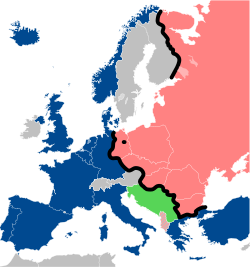Click chemistry
From Wikipedia, the free encyclopedia
Click chemistry is a term applied to chemical synthesis tailored to generate substances quickly and reliably by joining small units together. Click chemistry is not a single specific reaction, but describes a way of generating products that follows examples in nature, which also generates substances by joining small modular units. The term was coined by K. Barry Sharpless in 1998, and was first fully described by Sharpless, Hartmuth Kolb, and M.G. Finn of The Scripps Research Institute in 2001.[1][2]
A desirable click chemistry reaction would:[1]
In 1996, Guida calculated the size of the pool of drug candidates at 1063, based on the presumption that a candidate consists of fewer than 30 non-hydrogen atoms, weighs less than 500 daltons, is made up of atoms of hydrogen, carbon, nitrogen, oxygen, phosphorus, sulfur, chlorine and bromine, is stable at room temperature, and does not react with oxygen and water.[3] Click chemistry in combination with combinatorial chemistry, high-throughput screening and building chemical libraries speeds up new drug discoveries by making each reaction in a multistep synthesis fast, efficient and predictable.
Many of the Click chemistry criteria are subjective, and even if measurable and objective criteria could be agreed upon, it is unlikely that any reaction will be perfect for every situation and application. However, several reactions have been identified that fit the concept better than others:[clarification needed]
A desirable click chemistry reaction would:[1]
- be modular
- be wide in scope
- give very high chemical yields
- generate only inoffensive byproducts
- be stereospecific
- be physiologically stable
- exhibit a large thermodynamic driving force (> 84 kJ/mol) to favor a reaction with a single reaction product. A distinct exothermic reaction makes a reactant "spring-loaded".
- have high atom economy.
- have simple reaction conditions
- use readily available starting materials and reagents
- use no solvent or use a solvent that is benign or easily removed (preferably water)
- provide simple product isolation by non-chromatographic methods (crystallisation or distillation)
Explanation
Proteins are made from repeating amino acid units, and sugars are made from repeating monosaccharide units. The connections are carbon–hetero atom bonds C-X-C, rather than carbon–carbon bonds. In addition, enzymes ensure that chemical processes can overcome large enthalpy hurdles by a series of reactions each requiring only a small energy step. Mimicking nature in organic synthesis may facilitate the discovery of new pharmaceuticals given the large number of possible structures.In 1996, Guida calculated the size of the pool of drug candidates at 1063, based on the presumption that a candidate consists of fewer than 30 non-hydrogen atoms, weighs less than 500 daltons, is made up of atoms of hydrogen, carbon, nitrogen, oxygen, phosphorus, sulfur, chlorine and bromine, is stable at room temperature, and does not react with oxygen and water.[3] Click chemistry in combination with combinatorial chemistry, high-throughput screening and building chemical libraries speeds up new drug discoveries by making each reaction in a multistep synthesis fast, efficient and predictable.
Many of the Click chemistry criteria are subjective, and even if measurable and objective criteria could be agreed upon, it is unlikely that any reaction will be perfect for every situation and application. However, several reactions have been identified that fit the concept better than others:[clarification needed]
- [3+2] cycloadditions, such as the Huisgen 1,3-dipolar cycloaddition, in particular the Cu(I)-catalyzed stepwise variant,[4] are often referred to simply as Click reactions
- thiol-ene click reactions[5]
- Diels-Alder reaction and inverse electron demand Diels-Alder reaction[6]
- [4+1] cycloadditions between isonitriles (isocyanides) and tetrazines[7]
- nucleophilic substitution especially to small strained rings like epoxy [8] and aziridine compounds
- carbonyl-chemistry-like formation of ureas but not reactions of the aldol type due to low thermodynamic driving force.
- addition reactions to carbon-carbon double bonds like dihydroxylation or the alkynes in the thiol-yne reaction.
Azide alkyne Huisgen cycloaddition
One of the most popular[9][10] reactions within the Click chemistry concept is the azide alkyne Huisgen cycloaddition using a Copper (Cu) catalyst at room temperature. It was discovered concurrently and independently by the groups of Valery V. Fokin and K. Barry Sharpless at the Scripps Research Institute in California[11] and Morten Meldal in the Carlsberg Laboratory, Denmark.[12] Although the Cu(I)-catalyzed variant was first reported by Meldal and co-workers for the synthesis of peptidotriazoles on solid support, these authors did not recognize the potential of the reaction and did not make a connection with the click chemistry concept. Sharpless and Fokin independently described it as a reliable catalytic process offering "an unprecedented level of selectivity, reliability, and scope for those organic synthesis endeavors which depend on the creation of covalent links between diverse building blocks."Applications
Click chemistry has widespread applications. Some of them are:- Two-dimensional gel electrophoresis separation[13]
- preparative organic synthesis of 1,4-substituted triazoles
- modification of peptide function with triazoles
- modification of natural products and pharmaceuticals
- natural product discovery [14]
- drug discovery
- macrocyclizations using Cu(I) catalyzed triazole couplings
- modification of DNA and nucleotides by triazole ligation
- supramolecular chemistry: calixarenes, rotaxanes, and catenanes
- dendrimer design
- carbohydrate clusters and carbohydrate conjugation by Cu(1) catalyzed triazole ligation reactions
- Polymers and Biopolymers [15]
- surfaces[16]
- material science
- nanotechnology,[17] and
- Bioconjugation, for example, azidocoumarin.
- Biomaterials[18]
